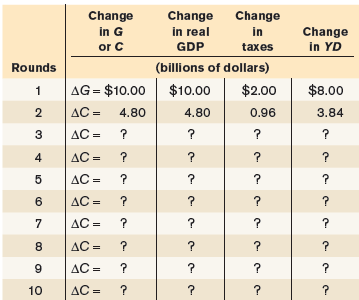An economy has a marginal propensity to consume of 0.6, real GDP equals $500 billion, and the
Question:

a. What is the total change in real GDP after the 10 rounds? What is the value of the multiplier? What would you expect the total change in real GDP to be, based on the multiplier formula? How do your two answers compare?
b. Redo the accompanying table, assuming the marginal propensity to consume is 0.75 and the government collects 10% of the rise in real GDP in taxes. What is the total change in real GDP after 10 rounds? What is the value of the multiplier? How do your two answers compare?
Fantastic news! We've Found the answer you've been seeking!
Step by Step Answer:
Related Book For 

Macroeconomics
ISBN: 978-1319120054
3rd Canadian edition
Authors: Paul Krugman, Robin Wells, Iris Au, Jack Parkinson
Question Posted:





